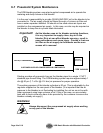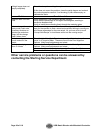
SGB Batch Blender with Mitsubishi Controller Page 87 of 118
Problem Possible solution
Check the Mixer and Dump Setup to see if the mixer is configured for
“Continuous Mixing”. Set it to “Timed Mixing”.
Check the value of the mixer timer setting.
Check the value of the dump delay timer.
Check the mixer motor fuse. This is located in the control panel on the
SSR for the mixer motor. If the unit has two (2) power inlets with a
separate power inlet for the mix motor the overload fuse will be located in
the rear junction box on the blender frame.
Check the power source to the blender.
Check the load cell in diagnostics under direct scale readout. Place a
calibration weight on the weigh hopper; determine if the weight
corresponds.
Check the load cells to make sure that a pellet has not jammed under a
load cell.
Check the load cell connections to the control panel
Check the power supply voltage and readjust as necessary as described
earlier.
Mixer won’t shut off and
runs continuously.
Check the memory battery voltage on the CPU board. If the battery is
dead, the blender “forgets” settings when the power is off. Replace it with
a new battery. Order a spare CPU board; send the replaced one back to
the factory to have a new battery holder and battery installed. If this is
done in the field, the controller warranty will be voided.
Go to the Manual Control Page and check to see if “Hop Low” equals “1”.
If it does, then adjust the low-level prox until the value reads “0”.
Out of Material Alarm is
displayed, but there is
material in the hopper.
Ensure that the material hopper is properly vented. If the vacuum
receiver is leaky, then this will cause the problem. To test this, fill up the
hopper and turn the loader off to prevent leaking.
If this isn’t the problem, then increase the “Out of Material Retry Limit”
found under Feed Algorithm Options (see manual).
I’m not getting Out of
Material Alarms
Check the Alarm Flags & Feeder Setup to see if the feeder is configured
to give you an alarm.
Calibration Weight
Exceeded
Clean out the hopper and retest. If this doesn’t fix the problem, then
perform a scale calibration. Also, check to sure that the Dump Time is
not set extremely low. If all else fails, check the value set for the Max
Empty Weight. This might need to be increased.
The feeder calibration
values are moving too
much.
First, check that the displayed actual dispensed weight is accurate. If this
is OK, then check to see if the hopper is properly vented. To do this, fill
hopper and turn off the loader and retest.
I can’t calibrate the Scale
without an error message.
This is caused by the difference in bits not being large enough. Using the
Direct Scale Readout, examine current loadcell bits with and without the
calibration weight. If the bits do not change significantly, then check for
pellets jamming the loadcells and check the loadcell circuit. You might
have a bad loadcell.
Do other feeders calibrate correctly? Is the feeder I’m trying to calibrate a
large gate? If these are true, then lower the Batch % for Feeder Cal
setting under Feed Calibration Options. This can be observed by looking
at the Hopper Weight display.
I can’t calibrate the feeder
without an error message.
None of the feeders calibrate? Check the Scale Calibration. If this is
correct, then lower the Batch% for Feeder Cal setting under Feed
Calibration Options for each feeder. This can be observed by looking at
the Hopper Weight display.


















